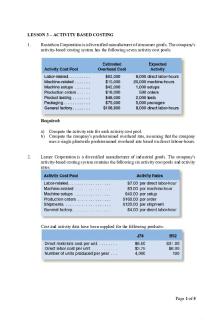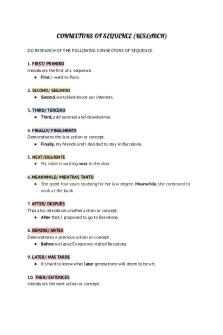ABC Sequence of Recording PDF

| Title | ABC Sequence of Recording |
|---|---|
| Course | Assessment, Case Planning, and Management |
| Institution | Metropolitan Community College, Nebraska |
| Pages | 2 |
| File Size | 109.9 KB |
| File Type | |
| Total Downloads | 67 |
| Total Views | 153 |
Summary
abc sequence...
Description
Parenting Tips AGES 2 - 8
The ABC’s of Charting Behavior What is the concern? Sometimes it feels like no matter what you do, some of your child’s challenging behaviors are hard to change. Due to busy schedules and feelings of frustration, many parents are unsure how often and under what circumstances their child’s behaviors even happen. Some parents feel at a loss about how to understand and manage their child’s behavior.
Why should I chart my child’s behavior? When simpler solutions don’t seem to be working, charting makes you more aware of what leads to your child’s behavior. It can help you figure out whether a behavior is positive or negative, how often it actually happens, and gives you clues about how to change it.
How do I chart my child’s behavior? Use “Antecedent-Behavior-Consequence” or an ABC chart to record behavior. This involves writing down what triggered the behavior (what happened just before the behavior occurred known as the Antecedent), the actual Behavior, and what happened afterward as a result (the Consequence). For example:
N Charting helps determine how often behaviors occur. N Use ABC to keep track of behaviors: What triggered the behavior?
Think about charting both behaviors you want to increase – like playing nicely – and decrease – like fighting. Overall, a child’s behavior changes much faster when you work on decreasing one behavior, “Stop fighting with your sister,” while increasing another desired behavior, “Play nicely with your sister.” For each behavior you should record how often it happens, the intensity (low to high), and how long it went on. Once you have about 10 incidents recorded, you may see patterns about what is causing your child’s behavior. You’ll have a better idea of what sets it off and what type of consequences keep it going; for example, if a child’s hitting behavior leads to more one-on-one attention from adults.
Tips for Charting
was the behavior, how long did it last, and how intense was it? What happened just after? N Explain to your child why you’re charting and keep the chart in a visible place. N If you need help planning your next steps, please talk with your child’s health care provider for more ideas.
different times of the day. just one to two hours per day. situations where the behavior occurs, then you might only have to record at those times, such as at dinner time or when you are on the phone. Page 1 NEMOURS HEALTH AND PREVENTION SERVICES
By Erin Carroll, MS Doug Tynan, PhD Lynn Chaiken, MSW Emotional and Behavioral Health
© 2009 The Nemours Foundation Nemours is a registered trademark of the Nemours Foundation EBH 10
*The term “consequence” can be tricky because we often think of it to mean punishment. In this case, consequence simply means the result of the behavior.
fewer problems at home. One of the problems we want to work on is having you and your sister fight less often with each other. So we’re going to first count how often you fight with each other AND how often you play nicely together.” your child what you are charting and remind you to count the behaviors.
Sample ABC Chart Antecedent (what happened just before? What time of day? Where?) 4:30 before dinner I told Sheila to clean up her toys.
Behavior She threw her toys at her sister.
How long did it last?
How intense? (Low to high)
Consequence (what happened just after?)
15 seconds
High
I yelled at her and picked up the toys.
Page 2 NEMOURS HEALTH AND PREVENTION SERVICES
Emotional and Behavioral Health...
Similar Free PDFs

ABC Sequence of Recording
- 2 Pages

Sequence Analysis of Carol
- 9 Pages

Recording of Transactions
- 1 Pages

Sequence
- 3 Pages

Chap-2-Recording of Transactions
- 11 Pages

ABC of Clinical Electrocardiography
- 89 Pages

Booting sequence
- 1 Pages

Sequence Analysis
- 1 Pages

Warranties, Recording
- 4 Pages

L3 ABC - ABC Questions
- 5 Pages

A brief history of field recording
- 24 Pages

The ABC model of Attitudes
- 8 Pages
Popular Institutions
- Tinajero National High School - Annex
- Politeknik Caltex Riau
- Yokohama City University
- SGT University
- University of Al-Qadisiyah
- Divine Word College of Vigan
- Techniek College Rotterdam
- Universidade de Santiago
- Universiti Teknologi MARA Cawangan Johor Kampus Pasir Gudang
- Poltekkes Kemenkes Yogyakarta
- Baguio City National High School
- Colegio san marcos
- preparatoria uno
- Centro de Bachillerato Tecnológico Industrial y de Servicios No. 107
- Dalian Maritime University
- Quang Trung Secondary School
- Colegio Tecnológico en Informática
- Corporación Regional de Educación Superior
- Grupo CEDVA
- Dar Al Uloom University
- Centro de Estudios Preuniversitarios de la Universidad Nacional de Ingeniería
- 上智大学
- Aakash International School, Nuna Majara
- San Felipe Neri Catholic School
- Kang Chiao International School - New Taipei City
- Misamis Occidental National High School
- Institución Educativa Escuela Normal Juan Ladrilleros
- Kolehiyo ng Pantukan
- Batanes State College
- Instituto Continental
- Sekolah Menengah Kejuruan Kesehatan Kaltara (Tarakan)
- Colegio de La Inmaculada Concepcion - Cebu



